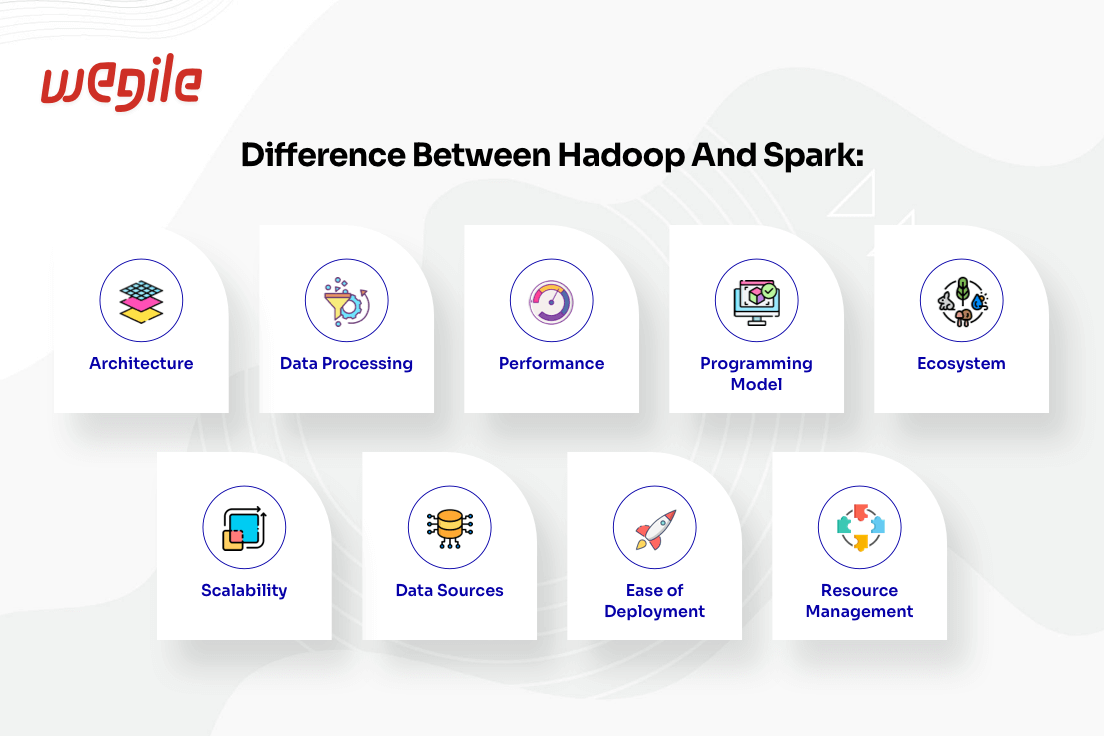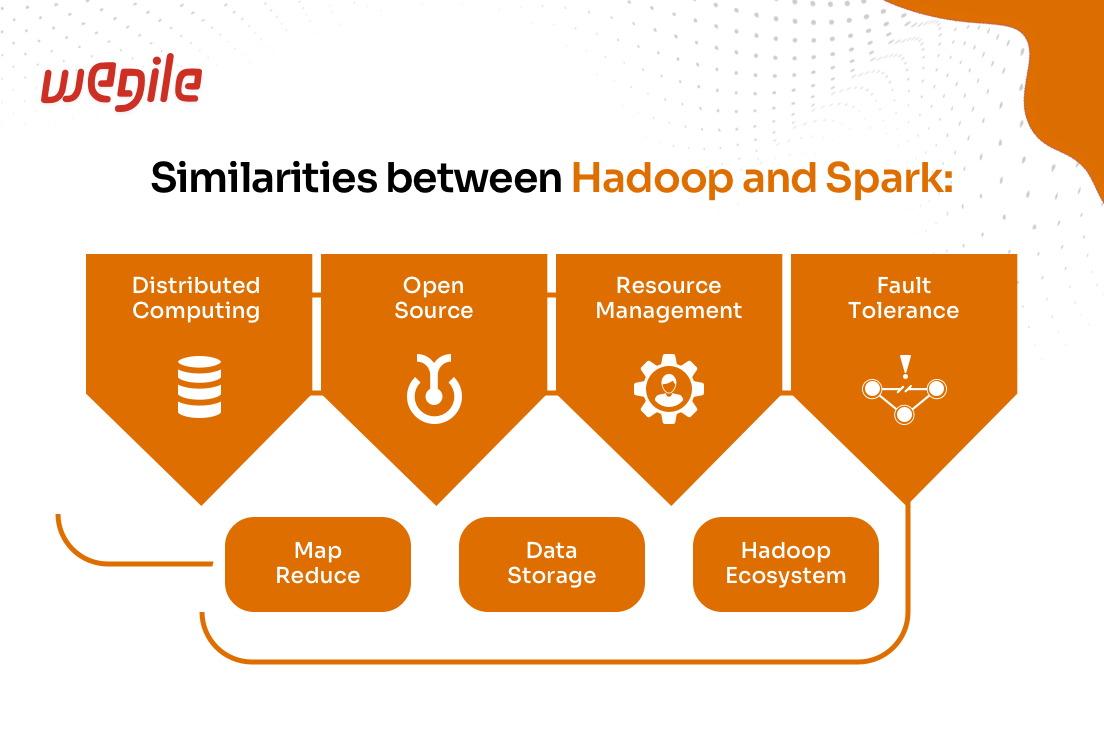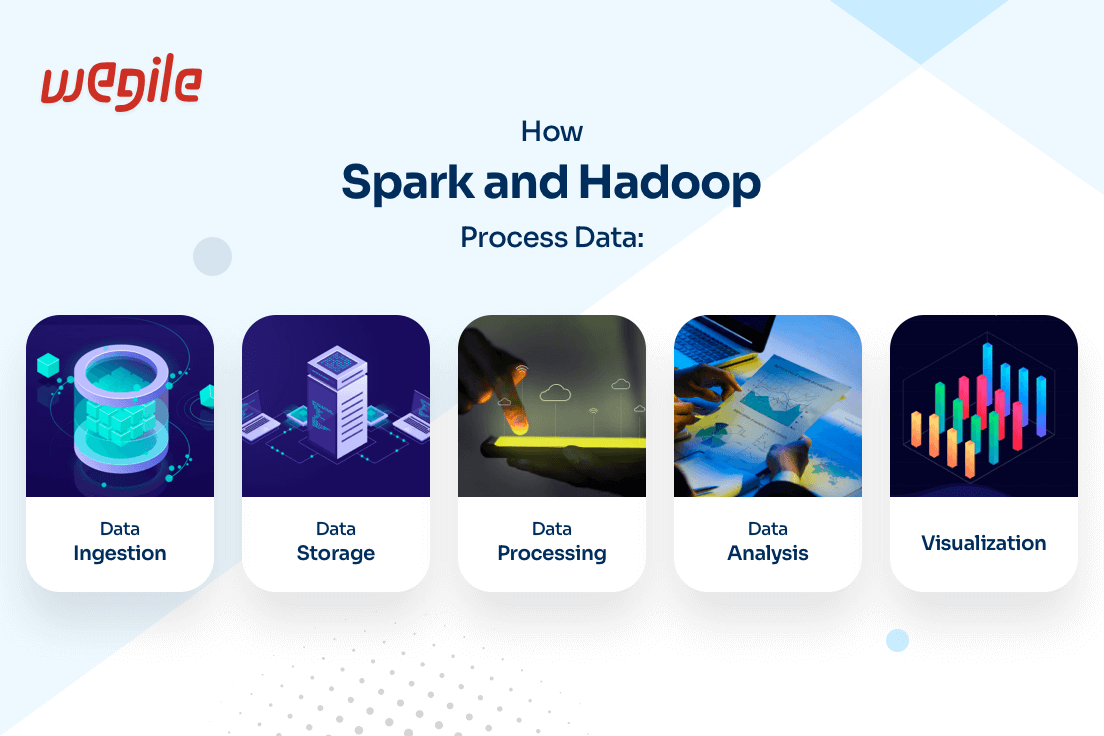Hadoop has become a mainstay in the industry, offering fast access and comprehensive analysis of huge datasets. By identifying correlations and patterns unseen by conventional methods, it delivers deeper insights into any process or system. Meanwhile, Spark is all about speed and scalability. It's designed to work with distributed frameworks so you can quickly perform operations on large amounts of data.
Learn more about the power of Hadoop and Spark – and how to use them for maximum effect in your analysis projects. With our in-depth exploration and insightful guidance, you'll soon be mastering the art of real-time analysis by understanding the differences between Hadoop and Spark, along with the similarities between Hadoop and Spark that they share.

Architecture: Hadoop is a distributed computing platform built around commodity hardware, meaning that it is highly scalable and requires no costly or specialized hardware. Spark's architecture uses in-memory caching and optimized query execution to run computations in memory, making it significantly faster than Hadoop when dealing with high-performance computing for data analysis.
Data Processing:Hadoop is designed for batch processing, which works well with large volumes of data that do not require fast input/output operations. Spark allows for both batch processing of large datasets as well as stream processing, enabling real-time analytics.
Performance: Hadoop’s batch processing system works well with high-volume, non-interactive operations. Its stream processing of large datasets is often slow and inefficient compared to Spark’s. Spark enables users to get faster results due to its in-memory computing capabilities and powerful optimization engine.
Programming model: Hadoop’s programming model is MapReduce, while Spark offers a higher-level API with a range of supported languages, including Java, Python, and Scala.
Ecosystem: Hadoop has an extensive set of components and services, including HBase and Pig for data storage and processing, as well as popular platforms such as Apache Hive for data analysis and Apache Mahout for machine learning. Spark also has a rich ecosystem but lacks the mature components found in Hadoop.
Scalability: Hadoop is excellent at distributing large amounts of data across a cluster of machines, while Spark works best with smaller data sets that require larger computing memory.
Data sources: Hadoop works with structured, semi-structured, and unstructured data, while Spark is mainly used for structured datasets.
Ease of Deployment: Hadoop is more difficult to deploy than Spark due to its complicated architecture and many components. Spark is easier to deploy since all the complex stitching between components is managed by its own integrated system.
Resource Management: Hadoop's resource-management system is baked into the framework, ensuring that MapReduce jobs are properly allocated resources, even for workloads with wildly differing pipelines. Spark's resource-management system is based on Apache YARN, which offers much more flexibility in how data is processed and takes advantage of available computing resources.
Use cases: Hadoop is great for batch processing, while Spark is better suited for iterative jobs that need faster speeds, such as machine learning, stream processing, and interactive querying.

Distributed computing: The power of Hadoop and Spark lies in their distributed computing capabilities, allowing for efficient data processing across multiple nodes. Perfect for harnessing collective computing power, these systems are unparalleled in their ability to accelerate workloads and optimize resource utilization.
Open-source: Hadoop and Spark are essential, open-source Big Data solutions that provide unprecedented levels of customization, enabling developers to craft powerful, tailored software. With the flexibility to modify and extend existing features, these platforms bring untold potential for developers.
Resource Management: Both Hadoop and Spark use their own resource management systems, referred to as “YARN” (Hadoop) and “Mesos” (Spark). These systems manage resources such as CPU cores and memory across the cluster, allowing distributed tasks to be executed with minimal interference.
Fault tolerance: Hadoop and Spark are the epitome of reliability and stability, staying ever-resilient to node failure, so even if catastrophe strikes, you can rest assured that your system will remain safe and secure. Hadoop's innovative mechanism for recovery is unrivaled in its ability to get those nodes back up and running, while Spark takes a slightly different approach, leveraging RDD Lineage to ensure fault tolerance.
MapReduce: Spark offers incredible speed and flexibility through its superior RDDs and DAG executor. In addition, it allows for seamless integration with existing Hadoop code and supports massive batch operations for the most demanding datasets – making sure that no obstacle stands in your way.
Data Storage: Drawing similarities between Hadoop and Spark, both technologies leverage distributed file systems – namely HDFS and S3 – to safeguard valuable data.
Hadoop Ecosystem: The Hadoop ecosystem is transformed through Spark's superior integration. Seamless compatibility with technologies such as Hive, Pig, and HBase enables developers to unlock the potential of data-driven computing and revolutionize their workflow.

In conclusion, Hadoop and Spark are two noteworthy big data technologies with the capability to process data in distributed settings. Hadoop is specifically tailored for batch processing, while Spark offers both batch and real-time solutions. Hadoop's architecture relies on cost-effective hardware components and an established ecosystem of elements like HBase and Pig.
In contrast, Spark utilizes in-memory caching processes and enhanced query execution to facilitate faster performance than Hadoop. Moreover, Spark provides a comprehensive programming model with comprehensive language backing while they both share advantages such as open source availability, fault tolerance, resource management systems, and distributed file systems like HDFS/S3 for data storage.


 Browse Our Services
Browse Our Services
